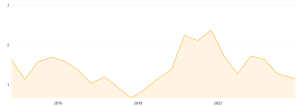Sometimes, investment analysts refer to a stock trading within a particular price range. Take insurer Aviva (LSE: AV.) as an example — over the past year, the share price has repeatedly headed towards £5.
Sometimes it has fallen back before getting there, while on other occasions (notably in April) it stayed above that level for a fairly short while before moving downwards again.
What, if anything, is keeping the price below a fiver per share? Could it smash that barrier?
Gaining momentum for a higher valuation
My answer is that there is nothing actually keeping the share price below the £5 level.
Put simply, prices are typically a function of how many people are willing to sell their shares at a given level and what demand there is to buy them for that much.
Aviva has been winning admirers in the City over the past couple of years for a focussed business strategy, decent financial performance, and strong dividend per share growth since a 2020 cut.
I think that helps explain why the insurer’s share price has been heading up over time, including 13% in the past 12 months alone.
Cash flow generation potential
That means that the current price-to-earnings ratio is 10. That sounds cheap, although for insurers, earnings are not always the best valuation metric in my view. They can move around a lot due to factors such as changes in the assets an insurer holds as part of its business.
What is clear, however, is that Aviva has a decent track record of being able to generate sizeable free cash flows. If that stays the same, it could help support both a juicy dividend, and a share price above £5 in my view.
General insurance premiums in the first nine months of this year were 15% higher than in the equivalent period last year. In the first half of the year, the company generated own funds under the Solvency II framework of £758m.
That demonstrates the FTSE 100 company’s ongoing ability to generate excess funds on a large scale.
Some possible risks along the way
Still, although the business momentum is positive and I think that could drive the share price above £5, it may not.
The business is now heavily focussed on the UK market. But I reckon that a weak economy, combined with high increases in insurance premiums in recent years, could lead to a tougher market in coming years, as at least some underwriters aim to grow their businesses by competing on price.
But if insurance market conditions remain strong in coming years and Aviva makes no significant missteps in its business, I think the shares could well pass £5 (just 3% higher than the current price) and potentially stay above that level.
Along with a 7% dividend yield, I think it is a stock investors should consider buying.
This post was originally published on Motley Fool






